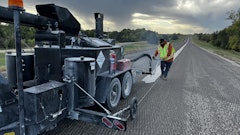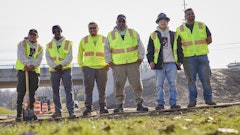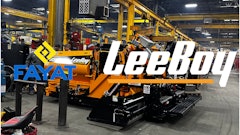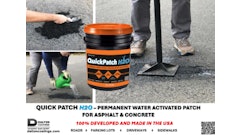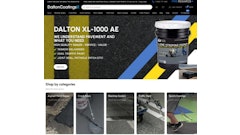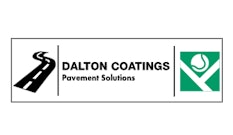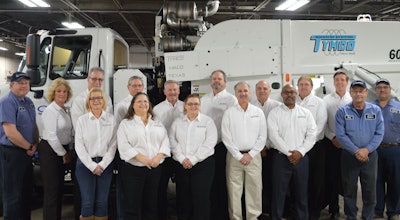
Pavement’s 2019 Sweeper of the Year, Contract Sweepers & Equipment, is possibly the most unique sweeping company in the country.
And it’s not just because the 58-year-old company is 100 percent employee owned, though that certainly plays a big part. It’s also because the management team believes in and pursues an openness and clarity of information provided to employees, including detailed bottom-line, dollars-and-cents figures the likes of which would make many owners cringe. And it’s because the company’s approach to its employees is enveloped in “the three Ps. People, Pride and Purpose.”
With headquarters in Columbus, OH, and locations in Dayton and Cincinnati, Contract Sweepers & Equipment is a multi-faceted sweeping business that in addition to generating 80% of revenue from contract sweeping, generates 20% from its equipment dealership which involves the sale, renting and repair of sweeper trucks. That diversification enables the company to provide customers with a broad variety of options for service, essentially being all things to all customers since they can mix and match their services to whatever the customer’s needs are.
“When we talk with a customer we want to give them the best advice and as many options as we can,” says Gerry Kesselring, president. “Do they want us to do the work? Do they want to rent the equipment and do it themselves? Do they want to buy the equipment? We do the work, rent equipment, sell equipment and maintain equipment. We look to provide the best solution for each customer.”
But the vast majority of their work is contract sweeping. Kesselring says parking lot sweeping accounts for 40 percent of sweeping their work, construction sweeping accounts for 30 percent, municipal sweeping accounts for 20 percent and the remainder is a mix of miscellaneous property services such as power washing, pothole repair, and graffiti removal. The company employs more than 100 people, of which more than 70 are sweeper operators.
“We’re good at what we do,” Kesselring says. “I’m blessed to have the people around me that I’ve got. My executive and leadership team are not only good for the company and the industry but good overall. It’s a great mix of people who understand what we need to do and they do it.”
The Transition to an ESOP
Contract Sweepers & Equipment was founded in 1960 by Tom Maish and his family. Kesselring joined in 1988 and became president in 1999. When Maish was ready to sell he determined that selling to an Employee Stock Ownership Plan (ESOP) could bring him some significant tax advantages.
ESOPs are nontaxable entities -- so they pay no federal tax. But when a person – an employee-owner -- retires or leaves the company they receive their investment and the money they receive is taxed as if they’re an individual.
Even though employees are owners, they don’t vote in day-to-day decisions. They vote only if somebody wants to buy the company. Should a vote occur votes are not one-person, one vote but are voted by shares. And employees can’t buy shares—instead shares are allocated based on wages and years of service.
Kesselring put together a team to buy the company through an ESOP and in 2004 the ESOP bought 100 percent of the company in one fell swoop, something that Kesselring says probably couldn’t be done today. He says they were able to do it then because in 2004 had and continues to have strong relationship with his banker. He says the biggest question at the time was with the bonding companies but once that was figured out the ESOP progressed smoothly.
“Then when we told the employees what we’d done they all kind of looked at us with glassy eyes,” Kesselring says. “‘What do you mean we’re the owners?’”
A Desire – and a Need – for Openness
He says that because there was some confusion and concern over the ESOP – in fact one night supervisor left because he didn’t think it was going to work – the management team that orchestrated the purchase realized they had to come up with a way to simplify how and what an ESOP is and what it means to the employee-owners.
“From the guys on the street to the executive team, we all have a vested interest in the overall growth, value and profitability of the company,” Kesselring says. “But we needed to find a way to convey that and to make sure everyone felt that not only were they a part of this company but that they were part-owners of this company.”
Management decided that to help the new employee-owners understand how the company was organized and managed now, they needed to be made aware of the information any business owner would have.
“So we shared our data and shared our information. We want everyone to understand that we’re all in this together and the more information they have the easier it is for them to understand that and be part of what we are doing,” Kesselring says. “Because employees are going to make up a story I’d rather have them make up a story based on the facts.”
So every year Kesselring gives what amounts to a state of the union address about the ESOP and they talk about it at monthly meetings. Kesselring says each month the management team reviews the company’s top seven revenue lines and more than a dozen key expenses and conveys that information to the employees. The company projects monthly and compares monthly projections to how the company performed the previous month – and everyone then knows that they’re either on track or off track.
“When we’re going good that’s great and when things are going bad they believe you because they’ve seen the data and they’ve seen it all along. We’ve never had a bad outcome as a result of being honest on where we stand,” he says.
“Part of the ESOP advantage is if an employee comes to us and wants to know why we won’t buy something – a new $90,000 sweeper, for example. Well, that employee has seen our numbers and knows our plans and goals and we can ask him, ‘Would you spend that money if you had to write the check? No? Then why would you think I should spend that money?”
And that, Kesselring says, lead to the decision to be wide open on the details of how the company is doing and even profitability.
“If my competition knows that my fuel costs are 6.9% of my revenue, I don’t really care. What are they going to do with that? But if my employees know that and we tell them it’s too high then we can ask them what we can do to bring that down. And because they are invested in the ownership of the company they have a vested interest in trying to figure that out. After all, you can’t manage what you can’t measure. So we try to give out as much measurement as we can.”
Kesselring says that one of the challenges of marketing the ESOP concept to employees was convincing younger employees of ESOP advantages. “When you’re 26 years old 66 is a long way off, so we had to work really hard to make that real to them,” Kesselring says. “But once some long-term employees started to retire and started to get their payments, word got around. There are a lot of gray hairs around this place and a lot of folks doing well because of the ESOP.”
People, Pride & Purpose
But also out of that desire for transparency and the efforts to convey what an ESOP means to everyone came Contract Sweepers & Equipment’s “People, Pride & Purpose” campaign.“We were trying to explain the ESOP to our folks in a way that is simple, meaningful and frankly marketable,” Kesselring says. “We needed them to understand what we are doing. Internally we’re constantly talking about People, Pride and Purpose – the three Ps. That’s our mantra and it’s what drives every decision we make.”
And with more than 100 people at the company, Contract Sweepers & Equipment makes it a point to make sure all those people are healthy and feeling part of the team. “I’m walking [AH1] the four corners of this building every day and it’s not to be seen -- it’s to see how people are doing,” Kesselring says. “I often make the statement, ‘you hire an employee and a person shows up.’ And that’s how we look at it. It becomes a question of how you are treating the individual.”
Among its people-focused efforts is an Employee Assistance Program that was set up to help employees and their families who might encounter any of a broad variety of challenges. “If you have family issues or life issues that are affecting you at home they are going to affect you at work, too,” Kesselring says. “We want to make sure we provide every opportunity for the people we work with to get the assistance they might need.”
The company also conducts training sessions for operators on the importance of proper sleep and insights to help that happen as well as how to help a family adjust to a third-shift worker.
The company produces a quarterly newsletter that includes this type of information, and the newsletter is sent to the employee’s home “because the whole family is something we’re supporting,” evidenced also by the fact that spouses are invited to all ESOP meetings. “They are part of what we’re doing here, too,” he says.
Kesselring says the “pride” aspect of the three Ps mantra comes from how people feel about where they work. So Contract Sweepers makes it a point to invest in its facility and invest in new equipment.
“We make sure that where we’re all working is a nice, clean, inviting place to go to work,” he says. “I’ve seen places where the third shift comes in and no one’s there and the lights are out and the heat is turned down. That’s not a place too many people are going to look forward to going to work at. We want this to be a good place where people want to come to work.”
And then there’s purpose. Kesselring says the management team and the employee-owners talk a lot about purpose, about why they are in business. And it’s not just to sweep.
“It’s to make money and that’s something everyone grasps easily,” he says. “But it’s also to make sure there’s a future for the people who work here. That’s the reason we match 401(k) contributions and it’s why we’re always encouraging people to contribute. It’s difficult to get a 26-year-old to be thinking about retirement but we encourage them to put that first 3% aside because once it’s there they’ll never miss it and they’ve begun planning their future. So there’s a greater purpose in what we’re doing than just sweeping.”
But the sweeping is an acknowledged purpose, too.
“We’re sweeping and that’s the job we’re supposed to be doing for our customers,” he says. “But sweeping has a greater importance. There’s an environmental impact to what we do and we make sure we focus on that, too.”

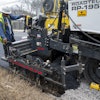


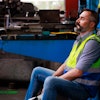
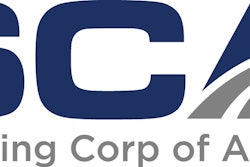
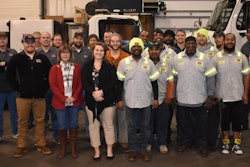
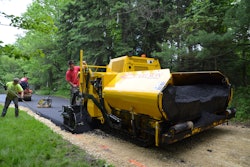

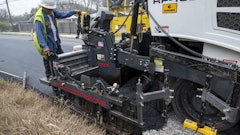

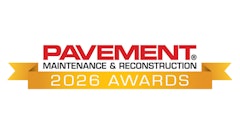
![Lee Boy Facility 2025 17 Use[16]](https://img.forconstructionpros.com/mindful/acbm/workspaces/default/uploads/2025/09/leeboy-facility-2025-17-use16.AbONDzEzbV.jpg?ar=16%3A9&auto=format%2Ccompress&fit=crop&h=135&q=70&w=240)

